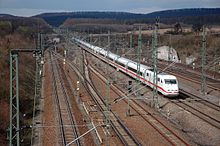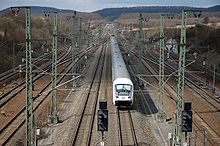Vaihingen (Enz) station
| Through station | |||||||||||||||||||||||||||||||||||||||||
 Station and forecourt | |||||||||||||||||||||||||||||||||||||||||
| Location | Vaihingen an der Enz, Baden-Württemberg Germany | ||||||||||||||||||||||||||||||||||||||||
| Coordinates | 48°56′49″N 8°57′30″E / 48.94704°N 8.95832°ECoordinates: 48°56′49″N 8°57′30″E / 48.94704°N 8.95832°E | ||||||||||||||||||||||||||||||||||||||||
| Owned by | Deutsche Bahn | ||||||||||||||||||||||||||||||||||||||||
| Operated by | |||||||||||||||||||||||||||||||||||||||||
| Line(s) |
| ||||||||||||||||||||||||||||||||||||||||
| Platforms | 4 | ||||||||||||||||||||||||||||||||||||||||
| Connections |
| ||||||||||||||||||||||||||||||||||||||||
| Other information | |||||||||||||||||||||||||||||||||||||||||
| Station code | n/a | ||||||||||||||||||||||||||||||||||||||||
| DS100 code | TV | ||||||||||||||||||||||||||||||||||||||||
| IBNR | 8006053 | ||||||||||||||||||||||||||||||||||||||||
| Category | 4 | ||||||||||||||||||||||||||||||||||||||||
| Fare zone | |||||||||||||||||||||||||||||||||||||||||
| Website | www.bahnhof.de | ||||||||||||||||||||||||||||||||||||||||
| History | |||||||||||||||||||||||||||||||||||||||||
| Opened | 30 September 1990 | ||||||||||||||||||||||||||||||||||||||||
| Services | |||||||||||||||||||||||||||||||||||||||||
| |||||||||||||||||||||||||||||||||||||||||
 | |||||||||||||||||||||||||||||||||||||||||
| Location | |||||||||||||||||||||||||||||||||||||||||
 Vaihingen (Enz) Location in Baden-Württemberg | |||||||||||||||||||||||||||||||||||||||||
Vaihingen (Enz) station is a long-distance and the regional station at an important railway junction in the town of Vaihingen an der Enz in the German state of Baden-Württemberg. It is classified by Deutsche Bahn as a category 3 station.
It is one of a few passenger stations in German that are designed to allow Intercity-Express (ICE) trains to pass at 250 km/h. The ICE through tracks do not have platforms.
Location[]
The station is located about 2.5 kilometers from the centre of Vaihingen, between the town and the suburb of Kleinglattbach[4] at about 250 metres above sea level.[5]
The station lies on the Mannheim–Stuttgart high-speed line (near the 78 km mark from Mannheim) and on the Württemberg Western Railway.
Structure[]

The railway system consists of eight tracks, which are numbered in ascending order in a northeasterly direction. In the middle of these tracks are the two tracks of the high-speed line for trains running at up to 250 km/h (track 4 and 5). Close by on both sides are two passing tracks (3 and 6). In the northeast is a platform for stopping passenger trains (tracks 7 and 8) and another platform to the south (tracks 1 and 2).
Trains to and from the new line can only stop at the platforms on tracks 2 and 7. Tracks 1 and 8 are used by regional trains running from Mühlacker to Bietigheim-Bissingen (track 1) or Bietigheim to Mühlacker (track 8). Fully grade-separated tracks prevent conflicts between high-speed and regional trains.[5] To the east of the station the high-speed tracks run through the 2.8 km-long and the track running towards Bietigheim crosses over the top of the tunnel, running to the north-east. Both regional tracks then run through the Nebenweg Tunnel. To the northwest of the station the regional track running towards Mühlacker passes under the high-speed tracks. At both ends of the station complex there are crossovers between the regional and high-speed tracks.
Travellers reach the platforms via two north-south subways. Outside the building there are ten to twelve buses, more taxis and more than 300 car parking spaces.[6]
The (now inactive) seven km long line rail passed under the site of the station. The new station includes a station on the Stadtbahn.[6] Operations on the line were abandoned at the end of 2002.[7]
Transport links[]



In long-distance operations (2019 timetable) the station is served by several regular InterCity (IC) services. In regional transport, the station is served by Interregio-Express (IRE) and Regional-Express (RE) services. The following lines stop here:
| Line | Route | Frequency |
|---|---|---|
| ICE 15 | Binz – Pasewalk – Berlin – Halle – Erfurt – Frankfurt – Darmstadt – Vaihingen – Stuttgart | Individual services |
| ICE 22 | Hamburg – Hannover – Göttingen – Kassel-Wilhelmshöhe – Frankfurt – Mannheim – Heidelberg – Vaihingen – Stuttgart | One train pair |
| ICE 45 | Cologne – Cologne/Bonn Airport – Siegburg/Bonn – Montabaur – Limburg Süd – Wiesbaden – Mainz – Mannheim – Heidelberg – Vaihingen – Stuttgart | One train pair |
| IC 30 | (Kiel – Neumünster –) Hamburg – Bremen – Osnabrück – Münster – Dortmund – Essen – Duisburg – Düsseldorf – Cologne – Bonn – Remagen – Koblenz – Mainz – Mannheim – Heidelberg – Vaihingen – Stuttgart | Every two hours |
| EC 32 | Münster – Recklinghausen – Gelsenkirchen – Oberhausen – Duisburg – Düsseldorf – Cologne – Bonn – Remagen – Koblenz – Mainz – Mannheim – Vaihingen – Stuttgart – Ulm – Günzburg – Augsburg – Munich – Traunstein – Freilassing – Salzburg – Villach – Klagenfurt | One train pair |
| IC 61 | Karlsruhe – Pforzheim – Mühlacker – Vaihingen – Stuttgart – Schwäbisch Gmünd – Aalen – Crailsheim – Ansbach – Nuremberg | Every two hours |
| IRE 1 | Karlsruhe – Pforzheim – Mühlacker – Vaihingen – Stuttgart (– Schorndorf – Schwäbisch Gmünd – Aalen) | Hourly, every two hours to Aalen |
| RB 17A | (Bad Wildbad/Wilferdingen-Singen –) Pforzheim – Mühlacker – Vaihingen – Bietigheim-Bissingen – Ludwigsburg – Stuttgart | Hourly (Mon–Fri: Pforzheim–Bietigheim half hourly) |
| RE 17B | Heidelberg – Bruchsal – Bretten – Mühlacker – Vaihingen – Bietigheim-Bissingen – Ludwigsburg – Stuttgart | Every two hours |
| RB 17C | Bruchsal – Bretten – Mühlacker – Vaihingen – Bietigheim-Bissingen – Ludwigsburg – Stuttgart | Every two hours |
The original concept was to have six to eight D-Zug express services on the Karlsruhe–Stuttgart route per day as well as an equal number of express services between the Frankfurt Rhine-Main region and Munich. InterCity-stops were not planned. In regional transport, the higher capacity of the new line would be used to add additional regional services if needed. With the connection between the new and old line, it was also possible to establish connections wuth Karlsruhe (towards Basel) and Stuttgart (towards Munich) that were previously not possible.[6]
The station also serves as an overtaking facility. These were arranged at a distance of about 25 kilometres apart along the new line that was put into operation in 1991.[6] As the originally planned mixed traffic of passenger and freight trains has not been realised, this facility is little used.
History[]
Planning[]
A major reason for building the station was to promote the urban development of the city of Vaihingen and it was envisaged that the core city would merge with the village of Kleinglattbach.[6]
Construction[]
The construction of the station complex began on 23 September 1985 with the establishment of the site. On 18 November actual work started on the crossing structures. The design of the station building was created by the Karlsruhe office of Schmitt, Kasimir & Partner and was selected as a result of an architectural competition. On 6 November 1987, a topping-out ceremony for the station building was celebrated and the building was finally completed in September 1990.[8] In the course of construction about ten kilometres of roads were built or rebuilt, along with cycling and foot paths.[9]
About 1.6 million m³ of soil was excavated for the 70 m wide and 2,000 m long station and 1.1 million cubic metres of new earth was put in place. 35 million marks were spent just for earthworks in the station area.[9]
Passenger traffic at the existing station in the centre of Vaihingen was abandoned at the timetable change of 30 September 1990.[8][10] At the same time the existing line was rerouted on a 7.31 km long section and a 1.36 km long single-track branch line to Vaihingen (Enz) North was put into operation.[8]
The commissioning of the new station shortened the travel time between Vaihingen and Stuttgart from 32 to 15 minutes.[6]
Notes[]
- ^ "Tarifzoneneinteilung" (PDF). Verkehrs- und Tarifverbund Stuttgart. 1 April 2020. Retrieved 16 April 2020.
- ^ "Der VPE Tarifzonenplan" (PDF). . Retrieved 19 February 2021.
- ^ "Wabenplan" (PDF). . 13 December 2020. Retrieved 19 February 2021.
- ^ Horst J. Obermayer: Neue Fahrwege für den InterCityExpress. In: Herrmann Merker (Hrsg.): ICE – InterCityExpress am Start. Hermann Merker Verlag, Fürstenfeldbruck 1991, ISBN 3-922404-17-0, p. 57–69.
- ^ a b Ernst Rudolph: Eisenbahn auf neuen Wegen: Hannover–Würzburg, Mannheim–Stuttgart, Hestra-Verlag, Darmstadt 1989, ISBN 3-7771-0216-4, p. 102 f.
- ^ a b c d e f Hartmuth, Rüdiger (1987). Reimers, Knut; Linkerhägner, Wilhelm (eds.). Neuer Bahnhof Vaihingen (Enz). Wege in die Zukunft. Neubau- und Ausbaustrecken der DB (in German). Darmstadt: Hestra Verlag. pp. 195–198. ISBN 3-7771-0200-8.
- ^ Wenn die DB (nicht) will. In: Eisenbahn-Revue International, 11/2002,ISSN 1421-2811, p. 490.
- ^ a b c Hans-Wolfgang Scharf: Die Eisenbahn im Kraichgau. Eisenbahn-Kurier-Verlag, Freiburg 2006, ISBN 3-88255-769-9, p. 202.
- ^ a b Deutsche Bundesbahn (ed.): Bahnhof Vaihingen (Enz). Brochure (four A4 pages), no location, no year (ca. 1986).
- ^ Jürgen Hörstel, Marcus Niedt: ICE – Neue Züge für neue Strecken. Orell-Füssli-Verlag, Zürich/Wiesbaden 1991, p. 20–24, ISBN 3-280-01994-X.
- Railway stations in Baden-Württemberg
- Railway stations in Germany opened in 1990
- Karlsruhe Stadtbahn stations
- Buildings and structures in Ludwigsburg (district)


